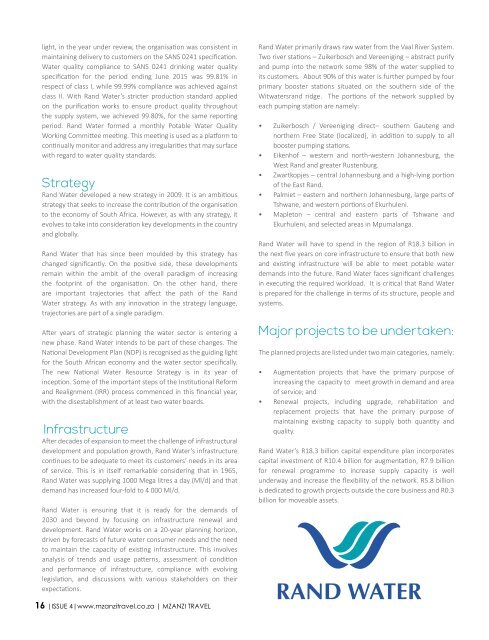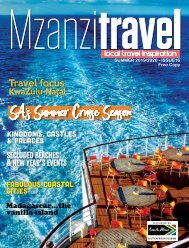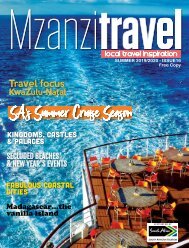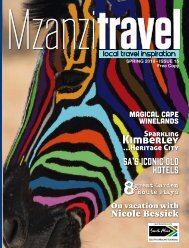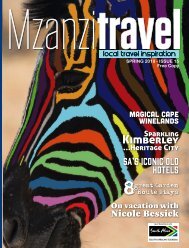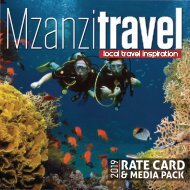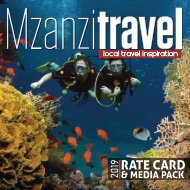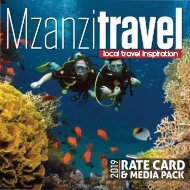Create successful ePaper yourself
Turn your PDF publications into a flip-book with our unique Google optimized e-Paper software.
light, in the year under review, the organisation was consistent in<br />
maintaining delivery to customers on the SANS 0241 specification.<br />
Water quality compliance to SANS 0241 drinking water quality<br />
specification for the period ending June 2015 was 99.81% in<br />
respect of class I, while 99.99% compliance was achieved against<br />
class II. With Rand Water’s stricter production standard applied<br />
on the purification works to ensure product quality throughout<br />
the supply system, we achieved 99.80%, for the same reporting<br />
period. Rand Water formed a monthly Potable Water Quality<br />
Working Committee meeting. This meeting is used as a platform to<br />
continually monitor and address any irregularities that may surface<br />
with regard to water quality standards.<br />
Strategy<br />
Rand Water developed a new strategy in 2009. It is an ambitious<br />
strategy that seeks to increase the contribution of the organisation<br />
to the economy of South Africa. However, as with any strategy, it<br />
evolves to take into consideration key developments in the country<br />
and globally.<br />
Rand Water that has since been moulded by this strategy has<br />
changed significantly. On the positive side, these developments<br />
remain within the ambit of the overall paradigm of increasing<br />
the footprint of the organisation. On the other hand, there<br />
are important trajectories that affect the path of the Rand<br />
Water strategy. As with any innovation in the strategy language,<br />
trajectories are part of a single paradigm.<br />
After years of strategic planning the water sector is entering a<br />
new phase. Rand Water intends to be part of these changes. The<br />
National Development Plan (NDP) is recognised as the guiding light<br />
for the South African economy and the water sector specifically.<br />
The new National Water Resource Strategy is in its year of<br />
inception. Some of the important steps of the Institutional Reform<br />
and Realignment (IRR) process commenced in this financial year,<br />
with the disestablishment of at least two water boards.<br />
Infrastructure<br />
After decades of expansion to meet the challenge of infrastructural<br />
development and population growth, Rand Water’s infrastructure<br />
continues to be adequate to meet its customers’ needs in its area<br />
of service. This is in itself remarkable considering that in 1965,<br />
Rand Water was supplying 1000 Mega litres a day (Ml/d) and that<br />
demand has increased four-fold to 4 000 Ml/d.<br />
Rand Water is ensuring that it is ready for the demands of<br />
2030 and beyond by focusing on infrastructure renewal and<br />
development. Rand Water works on a 20-year planning horizon,<br />
driven by forecasts of future water consumer needs and the need<br />
to maintain the capacity of existing infrastructure. This involves<br />
analysis of trends and usage patterns, assessment of condition<br />
and performance of infrastructure, compliance with evolving<br />
legislation, and discussions with various stakeholders on their<br />
expectations.<br />
Rand Water primarily draws raw water from the Vaal River System.<br />
Two river stations – Zuikerbosch and Vereeniging – abstract purify<br />
and pump into the network some 98% of the water supplied to<br />
its customers. About 90% of this water is further pumped by four<br />
primary booster stations situated on the southern side of the<br />
Witwatersrand ridge. The portions of the network supplied by<br />
each pumping station are namely:<br />
• Zuikerbosch / Vereeniging direct– southern Gauteng and<br />
northern Free State (localized), in addition to supply to all<br />
booster pumping stations.<br />
• Eikenhof – western and north-western Johannesburg, the<br />
West Rand and greater Rustenburg.<br />
• Zwartkopjes – central Johannesburg and a high-lying portion<br />
of the East Rand.<br />
• Palmiet – eastern and northern Johannesburg, large parts of<br />
Tshwane, and western portions of Ekurhuleni.<br />
• Mapleton – central and eastern parts of Tshwane and<br />
Ekurhuleni, and selected areas in Mpumalanga.<br />
Rand Water will have to spend in the region of R18.3 billion in<br />
the next five years on core infrastructure to ensure that both new<br />
and existing infrastructure will be able to meet potable water<br />
demands into the future. Rand Water faces significant challenges<br />
in executing the required workload. It is critical that Rand Water<br />
is prepared for the challenge in terms of its structure, people and<br />
systems.<br />
Major projects to be undertaken:<br />
The planned projects are listed under two main categories, namely:<br />
• Augmentation projects that have the primary purpose of<br />
increasing the capacity to meet growth in demand and area<br />
of service; and<br />
• Renewal projects, including upgrade, rehabilitation and<br />
replacement projects that have the primary purpose of<br />
maintaining existing capacity to supply both quantity and<br />
quality.<br />
Rand Water’s R18.3 billion capital expenditure plan incorporates<br />
capital investment of R10.4 billion for augmentation, R7.9 billion<br />
for renewal programme to increase supply capacity is well<br />
underway and increase the flexibility of the network. R5.8 billion<br />
is dedicated to growth projects outside the core business and R0.3<br />
billion for moveable assets.<br />
16 |ISSUE 4|www.mzanzitravel.co.za | MZANZI TRAVEL


